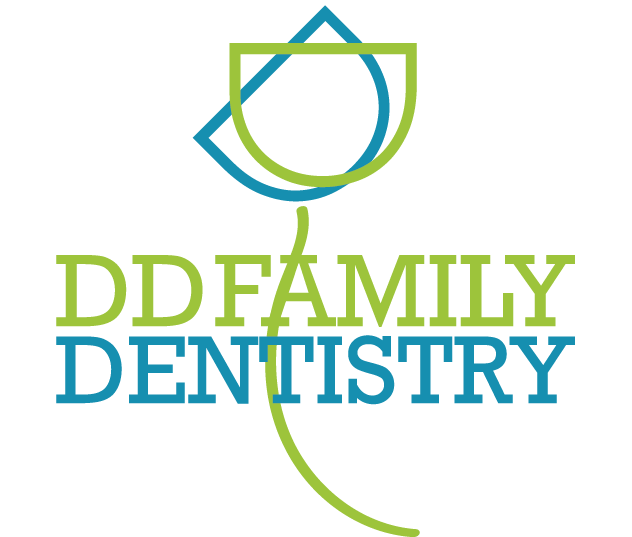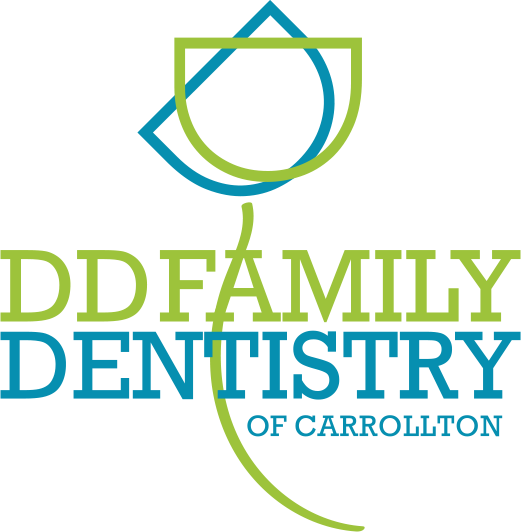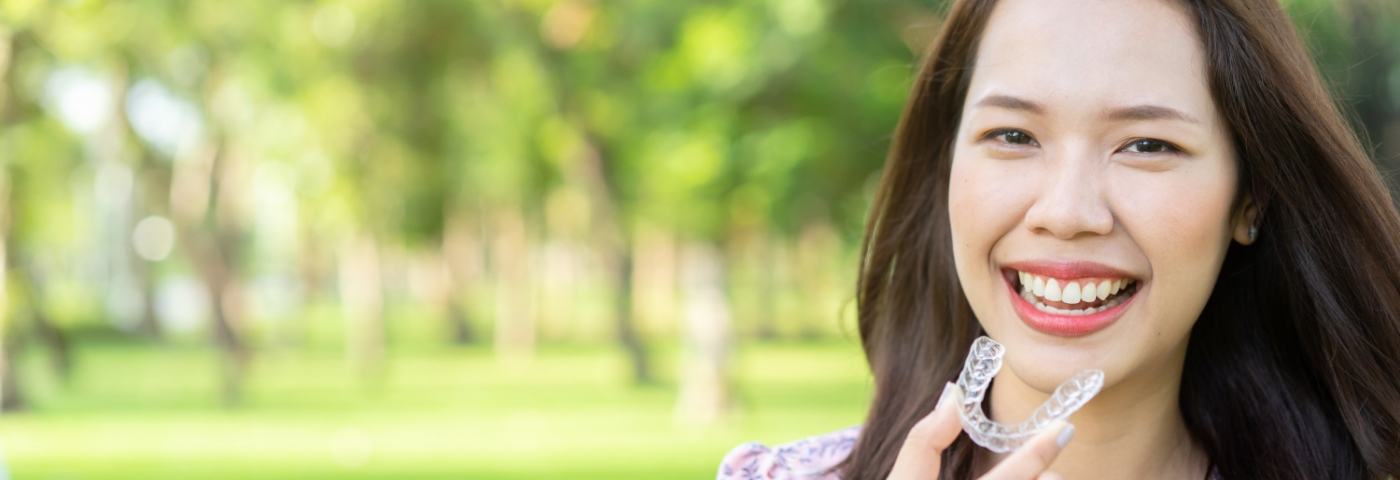Invisalign® Carrollton
We Create Straighter Smiles with Clear Solutions
Misaligned teeth can negatively impact your confidence, causing you to hide your smile. However, it also hurts your oral health as the teeth are more difficult to clean, which makes you more prone to gum disease and tooth decay. Although you have probably considered braces in the past, you might not want to feel insecure about visible metal wires and brackets. At DD Family Dentistry near Castle Hills, we understand your concern, which is why we offer a more sophisticated treatment. With Invisalign® in Carrollton, you will improve your self-esteem and dental health with a nearly invisible choice, so call us today.
Why Choose DD Family Dentistry of Carrollton for Invisalign®?
- Top-Rated Dental Team on Google
- Dentist with 10+ Years of Experience
- Convenient Hours, Including Saturdays
How Invisalign® Works
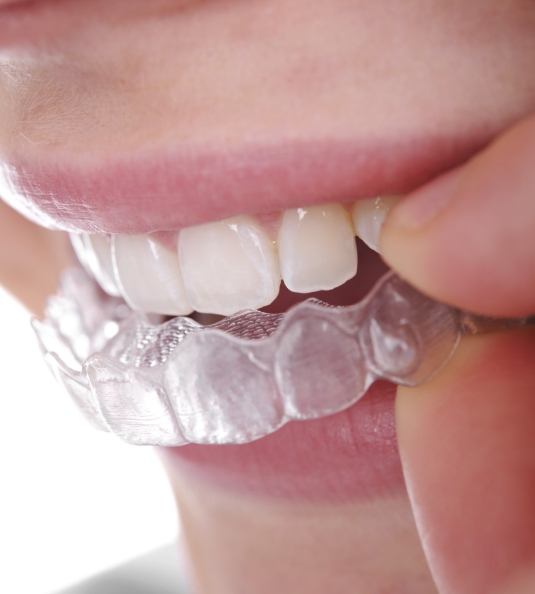
Invisalign® provides high-quality results when used to correct an array of bite and alignment issues. After determining that you are a candidate for the treatment, we use 3D scans of your teeth to create a series of aligners. This technology allows us to move your teeth with precision while also showing you what your new smile will look like—even before you commit to treatment.
You will wear each aligner for about two weeks. Since no wires are used, you do not need to have adjustment appointments. However, you will still need to come in every few weeks so we can monitor the progression of the treatment.
You will wear each aligner for about 22 hours per day, only taking them out when eating, drinking, or caring for your teeth or the aligners. In about 12 months, you will have a straight, confident smile. To protect your results, you will briefly need a retainer to prevent your teeth from moving back into their previous positions.
Who Can Invisalign® Help?
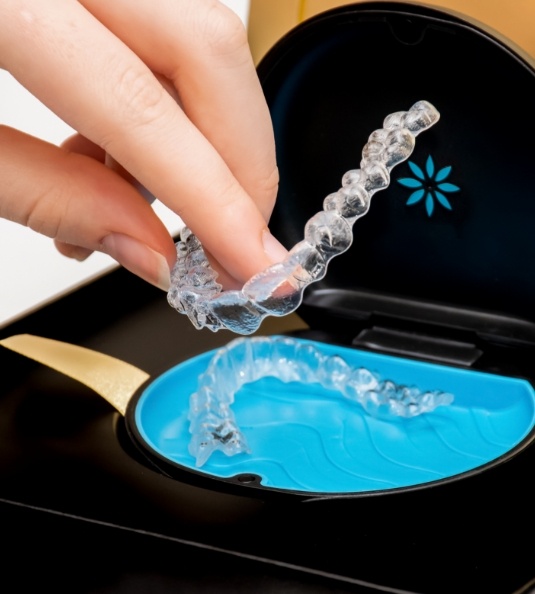
Fortunately, Invisalign® can address several common orthodontic concerns, from mild gaps to moderate overcrowding. If you want to learn more on the topic leading up to your consultation, then read on!
Crowded Teeth

One of the most common orthodontic problems is overcrowding. This misalignment issue can negatively impact your oral health and your bite. Fortunately, we can use clear aligners to move your teeth into their properly aligned positions, improving the appearance, health, and function of your smile in the process.
Gaps Between Teeth
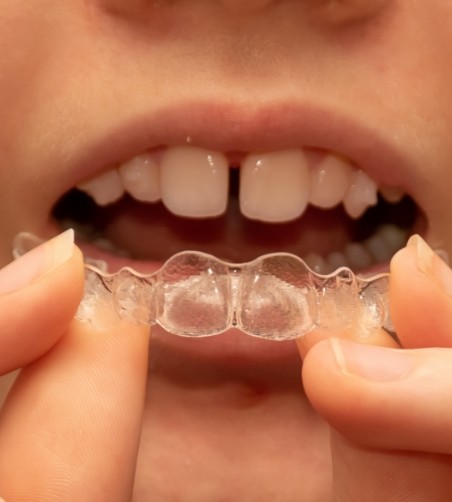
Like crooked teeth, spaced-out teeth can take a toll on your self-esteem, and they can trap food debris, increasing your risk of decay. With Invisalign®, you don’t have to wear metal brackets and wires to close the gaps! Instead, each see-through tray will bring your teeth closer and closer together until your teeth are perfectly aligned.
Overbite
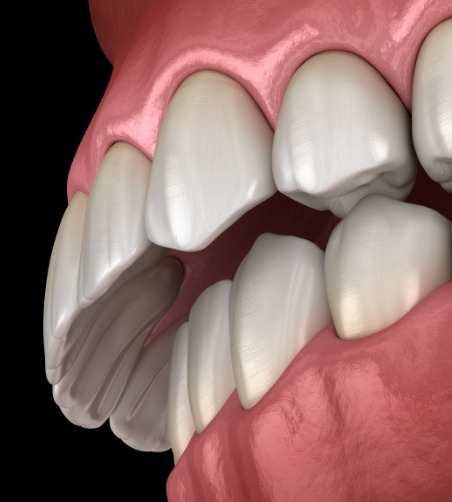
An overbite happens when the top teeth come out too far from the lower arch of the teeth. Overbites result in jaw pain, speech issues, uneven dental wear, and difficulty opening and closing the mouth. This problem can also leave the top teeth more exposed, putting them at higher risk of becoming injured.
Underbite
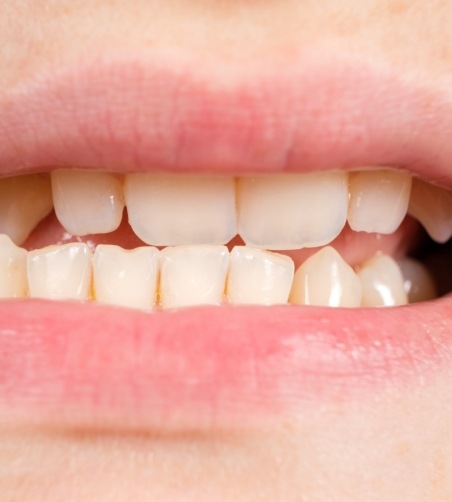
An underbite refers to when the bottom teeth protrude out over or match with the top row of teeth when you close your mouth. This can be caused by several different factors, including genetics, jaw injury, and nonnutritive habits – like thumb sucking and pacifier use after a certain age. A lot of the time, patients with underbites require the use of rubber bands or other attachments to be used in combination with Invisalign® aligners. This helps to gradually address the bite and move the lower arch back into its proper place.
Crossbite
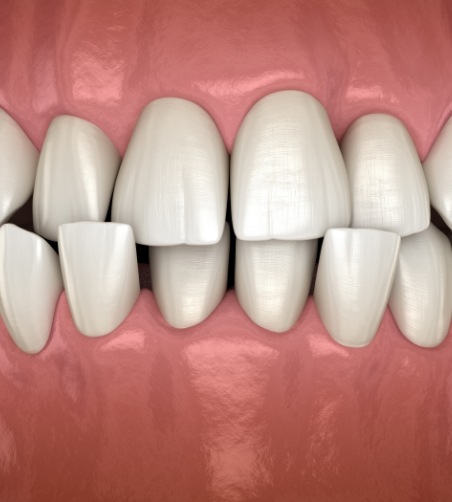
When the bottom teeth are slightly in front of the upper arch, this is called a crossbite. This is usually caused by genetics, poor oral habits, or premature loss of baby teeth. When left unaddressed, crossbites can lead to other issues, like increased risk of gum disease, tooth decay, speech difficulties, headaches, teeth grinding, and facial asymmetry. Invisalign® can correct this issue in the majority of cases. However, if your crossbite is caused by issues involving jaw development, it may be necessary to accompany the aligners with elastics and other accessories.
Open Bite
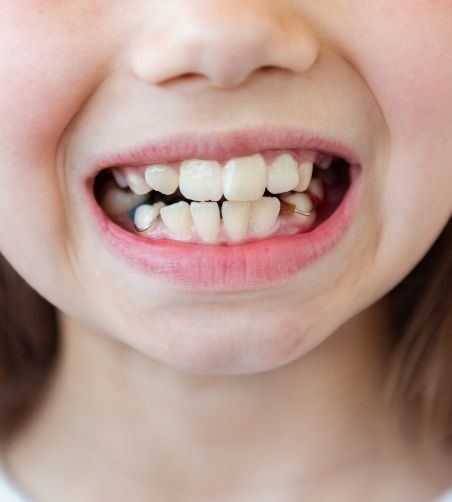
An open bite is when the top and bottom front teeth aren’t able to overlap or touch when you close your mouth all of the way. This is usually caused by poor bone development or nonnutritive habits, like prolonged thumb sucking and pacifier use. An open bite can lead to difficulty pronouncing certain words and sounds, as well as excessive enamel wear of the back teeth. Invisalign® can bring the top and bottom teeth together, correcting the bite pattern and reducing oral damage.
The Benefits of Invisalign®

Metal brackets and wires are no longer necessary for patients to achieve straighter smiles! In addition to being virtually invisible, Invisalign® offers certain benefits that are not possible with other treatments. Here are some of the advantages that our patients appreciate the most!
Improved Comfort
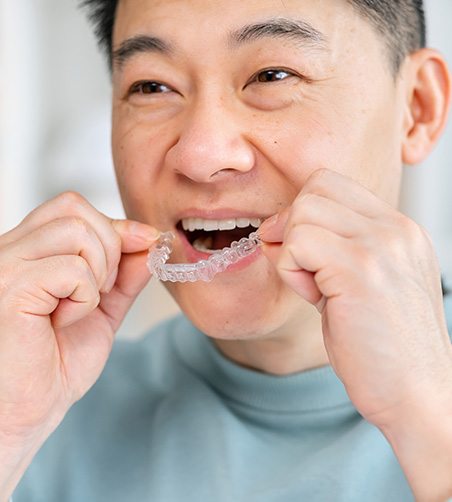
When you have traditional braces, there are pointy brackets and wires present that can irritate the soft tissues of the mouth, resulting in tenderness and soreness. Invisalign uses smooth, clear plastic aligners to straighten the teeth, so they shouldn’t cause discomfort to the surrounding tissues – just some minor soreness when you switch to a new set of aligners.
Discreet Trays

When you have traditional braces, it’s something that everyone around you can see. This deters many older teens and adults from getting orthodontic treatment. On the other hand, Invisalign allows you to receive a healthy, beautiful smile without compromising your appearance in the meantime.
Better Dental Hygiene
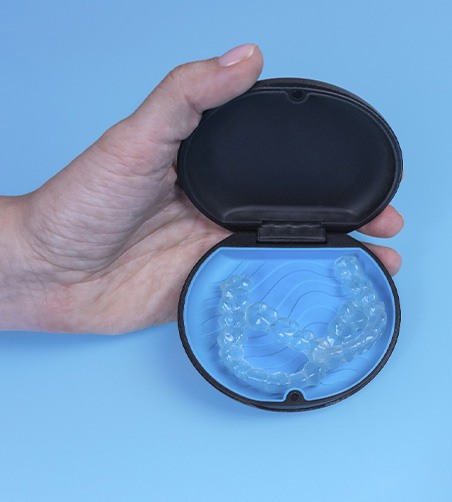
With traditional braces, it’s easy for food to become stuck in your braces. It’s also challenging to thoroughly clean your teeth. With Invisalign, you can remove your aligners when it’s mealtime. Then, you just clean your teeth as normal before putting the aligners back in your mouth. There’s no need to navigate around metal brackets and wires.
Quick Follow-Ups
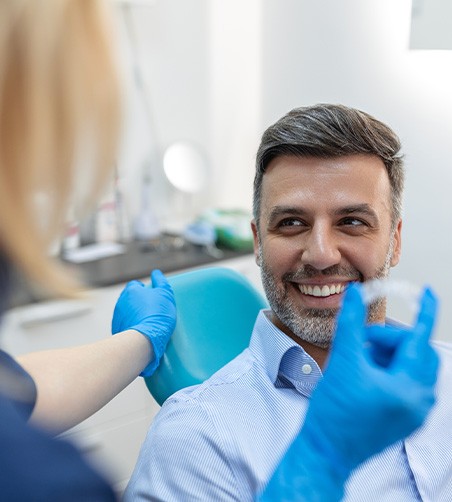
People with traditional braces need to go to the dental office frequently to have adjustments made and their braces tightened. Since Invisalign uses clear aligners, nothing needs to be tightened. However, you still need to attend a quick follow-up every once in a while to make sure everything is moving as planned. This way, if something unexpected happens, we can update your treatment plan.
Boosted Confidence

When you are happy about the appearance of your teeth, you will be more confident showing them off. Having additional confidence can improve your life in a variety of ways, including your social life and professional life.
Non-Invasive Treatment
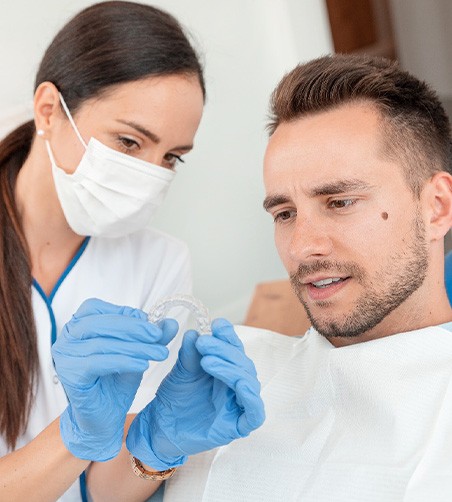
Thanks to technological advancements, Invisalign doesn’t use any invasive measures to prepare your teeth. If you closely follow the instructions of your dentist, your treatment should be a breeze!
Living with Invisalign® Aligners
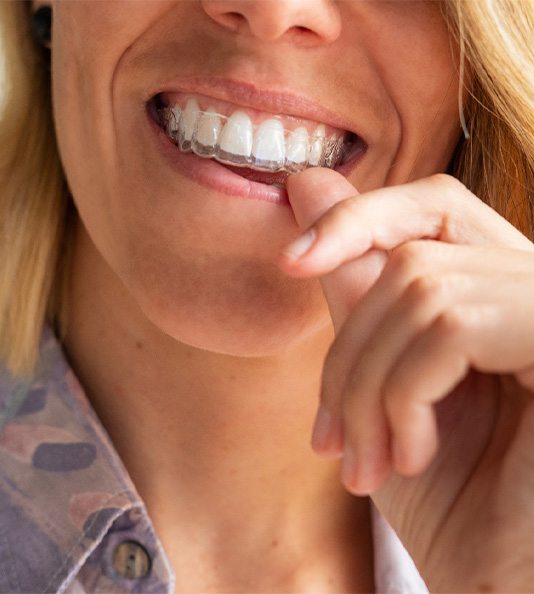
If you are thinking about getting Invisalign or are starting your first set of trays in the near future, it pays to be informed about what life with your clear aligners will look like. To help you get prepared, we’ve put together a few things that you should know to keep your smile on track during your treatment. Keep reading to learn more!
Wearing Your Trays
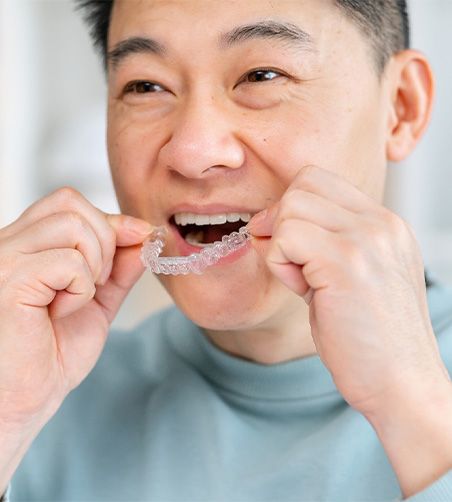
One of the great benefits of Invisalign is the fact that you can remove your trays whenever you want to eat. However, this means that you need to be disciplined about putting them back in within a timely manner to keep your treatment on track. You should make the intentional effort to keep your aligners in for at least 20-22 hours each day so that your teeth keep shifting as anticipated. You should only take them out to eat, drink (non-water), and complete your oral hygiene regimen.
Cleaning Your Aligners

You’ve already invested in your Invisalign treatment, so you don’t need to buy any expensive or fancy products to keep your trays clean. All you need is a soft-bristled toothbrush and clean water. Carefully use the toothbrush to brush each surface. If your aligners are looking a bit stained, or you want extra freshness, you can use your Invisalign cleaning crystals.
Eating & Drinking
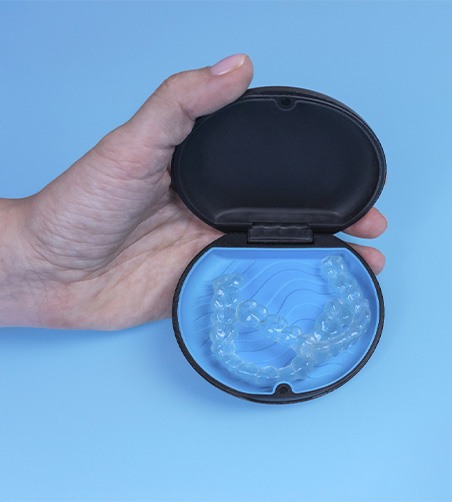
You take your Invisalign out when it’s time for meals, so you don’t need to worry about restricting your diet. However, there are still some tooth-healthy practices that we recommend implementing – especially during your orthodontic treatment. Getting a cavity at this time could mean putting your treatment on hold until you can get the necessary restorative care. Be mindful of the number of sugary foods and beverages you are consuming and be sure to drink plenty of water to stay hydrated. You should always thoroughly brush and floss your teeth before putting your aligners back in. Additionally, be especially careful when eating hard and crunchy foods if you have attachments on your teeth. You don’t want them to come off!
Losing or Damaging a Tray
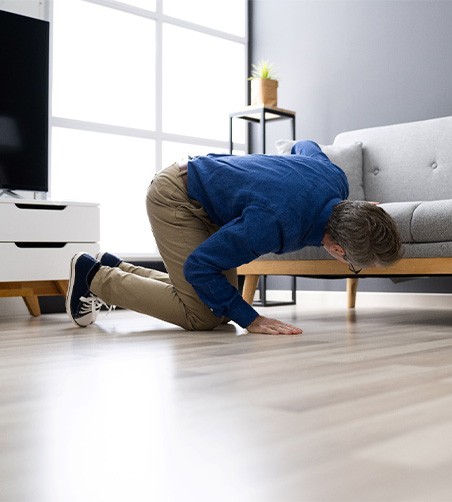
When you aren’t wearing your aligners, you should always keep them in their case and in a safe place to minimize your chances of losing one. If this unfortunate situation does happen, you should let us know right away so we can give you further instructions. If one of your trays has become damaged, don’t try to repair it on your own. Instead, give us a call so we can decide what the best next steps are.
Routine Check-Ins
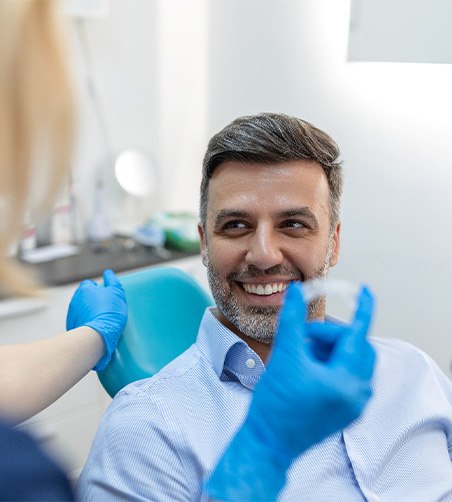
In addition to receiving your new aligners during your routine checkups, we also examine your smile to ensure that everything looks as it should. This way, we can keep you on track for your treatment and make any adjustments if needed. This is also a good time to ask any additional questions that come up as you are going through your orthodontic treatment.
How Much Does Invisalign® Cost?

Clear aligners are a great solution to improve your smile without worrying about brackets and wires. However, there’s a lot of misinformation about the cost of Invisalign®. It’s likely more affordable than you realize. Although there’s not a flat rate for Invisalign®, we strive to keep a straight, healthy smile achievable for everyone. We offer various financial solutions to invest in your oral health and self-esteem without breaking the bank.
Factors That Affect the Cost of Invisalign®
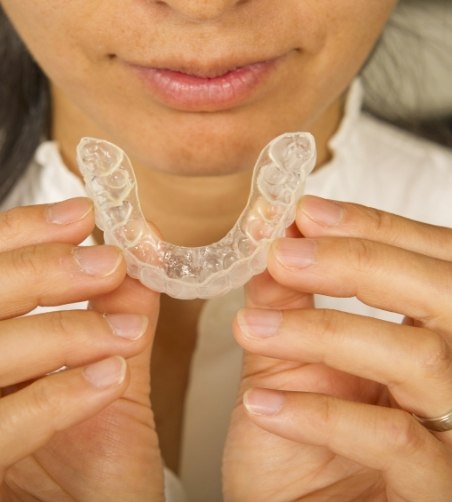
No two smiles are identical, so it’s impossible to use a cookie-cutter treatment plan. As a result, several factors will influence the amount you’ll pay. Your Invisalign® dentist will examine your mouth to create a personalized strategy to fix your bite and alignment concerns. We’ll provide you with an estimate and explain the fees associated with your plan. You can expect your estimate to include:
- Preparatory Treatments : Some patients need a little prep work before Invisalign®, such as fillings or gum disease treatment.
- Number of Arches : Your estimate will include the costs for treating one or both arches.
- Complexity : Major tooth movements will require more aligners, which will add to the cost.
Invisalign® vs. “Do It Yourself” Clear Aligners: Which Costs More?
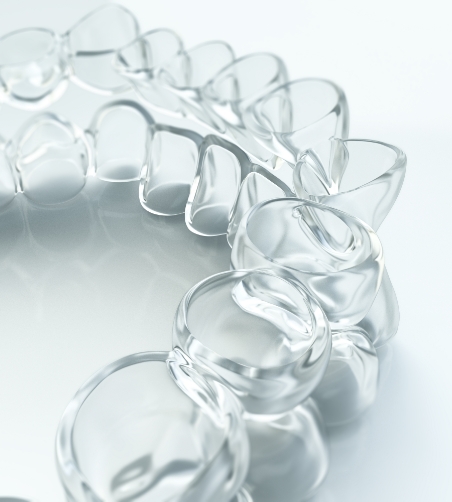
Everyone likes to save money, which makes mail-order aligners appealing. Although they may seem identical to aligners from your dentist, there’s a major difference. You won’t be under the care of a dental professional. As a result, you can open the door to irreversible damage without the right supervision. Despite your intent to save money, mail-order braces can cost significantly more down the road should problems occur that need to be fixed by a professional. It’s better to pay for the qualifications and experience of a trusted dentist to safely reach your goals.
Does Dental Insurance Cover Invisalign®?
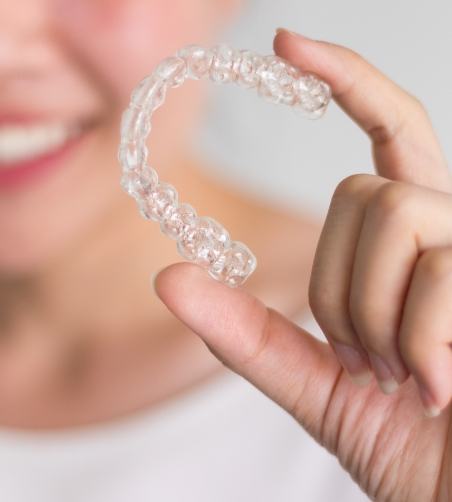
Every dental plan is different, but many offer coverage for orthodontics. Dental insurance won’t cover the entire cost of the treatment, but you can use your benefits to offset the amount you’ll pay for certain steps in your plan, like the consultation. Depending on your coverage, you are given a set allowance to use toward the cost after meeting your deductible. We will work on your behalf with your dental insurance to maximize your benefits to keep a straight smile within your budget.
Options for Making Invisalign® Affordable

Besides using your dental insurance, we offer multiple solutions to keep Invisalign® affordable, including:
- Traditional Payments: We accept all forms of traditional payments, including cash, checks, and credit cards.
- Dental Savings Plan: Our office has an in-house savings plan, which allows you to benefit from reduced rates for common services after an annual membership fee.
- New Patient Specials: Ask us about any current new patient specials.
- Third-Party Financing: Pay for your treatment using monthly installments through a third-party financing company, like CareCredit.
If you’re ready to invest in the smile you deserve, or you have questions about your payment options, contact our office today. We look forward to turning your dream smile into a reality.
Invisalign® FAQs
How will Invisalign® affect my life?
One of the most significant benefits of Invisalign® compared to other options like traditional braces is that it can seamlessly fit into your daily life. The adjustment period is short, allowing you to wear your aligners comfortably as well as speak and eat with complete ease. In fact, your aligners are removable, so you won’t have to change your diet in any way to accommodate your orthodontics. Plus, because of their clear appearance, you can feel confident smiling in any social or professional setting.
How should I care for my aligners?
A successfully straight smile at the end of treatment is only possible if you care for your aligners properly throughout the process. Invisalign® offers its own cleaning system to make it easy, but you can also use room-temperature water, a soft-bristled toothbrush, and clear hand soap. Avoid using hard-bristled brushes because they can scrape the plastic, and hot water can warp your aligners. When cleaning, it’s a great idea to put down towels on the sink and/or floor. That way, if you drop one of your aligning trays, there will be something soft to break its fall and avoid damage.
What should I do if I lose an aligner?
Because Invisalign® is removable, you can break or misplace your aligners. If this occurs, contact our office right away for a replacement. The sooner we can give you your correct tray, the quicker you can get back on track with your treatment time. In most cases, we will instruct you to use the previous aligner until we can get you a new one. If you don’t get your aligner replaced, your teeth can begin to shift back into their crooked positions, losing the progress you gained since you started.
How can I be sure that Invisalign® will work?
While traditional braces have been the go-to orthodontic treatment historically, Invisalign® has been used for around 20 years to give patients a beautifully straight smile. In a large survey, patients gave Invisalign® a 96% satisfaction rating, and 90% of participants said they would recommend it to friends and family. Plus, our experienced team will be with you every step of the way to ensure the entire process goes smoothly with routine checkups every 6 to 8 weeks.
If you’re ready to get started on a better way to achieve the smile of your dreams, contact our office to set up a consultation!
Does Invisalign Hurt?
Sometimes, patients are hesitant to commit to clear aligner treatment because they are scared it will hurt (especially those who have had traditional braces in the past). Don’t worry – Invisalign is considerably more comfortable! That’s largely due to the fact that the trays are custom-made for each patient, and they are crafted from smooth, metal-free plastic. So, while you can expect to experience some soreness from time-to-time as your teeth move, you won’t have to deal with persistent soft-tissue irritation.
Is There Anything I Can’t Eat with Invisalign?
One of the many reasons patients love Invisalign is because there aren’t any dietary restrictions. That doesn’t mean, however, that you don’t need to be mindful of what you eat. After all, over-indulging on sugary and starchy snacks can result in tooth decay, which would bring your teeth-straightening journey to a temporary stop. For that reason, we recommend eating lots of nutrient-dense foods, like fresh fruits and vegetables. We also recommend keeping crunchy and sticky foods to a minimum, including hard pretzels and taffy.
How Long Does Invisalign Take?
Invisalign usually takes between 12 and 18 months. Of course, there are some exceptions. For example, if you consistently misplace your aligners, it may take two or more years to get the desired results. Conversely, if your case of malocclusion is relatively minor, your orthodontic treatment may be six months or less.
How Long Will I Need to Wear My Aligners Per Day?
The general rule of thumb is 20-22 hours. However, the more you wear them, the better! The best way to achieve this goal day-in and day-out is by only taking them out when absolutely necessary, like before eating. You should also multi-task where you can, like soaking your trays in a dentist-recommended cleaner while you eat your dinner. If you’re having trouble meeting your wear-time, then let us know. We’d be more than happy to share tips that have worked for our patients in the past.
Who is Not Eligible for Invisalign?
Although Invisalign is suitable for a wide range of patients, there are some exceptions. To start, we can’t start the teeth-straightening process if decay or an infection is present. Clear aligners also aren’t suitable for those with severe malocclusion. The good news is that preliminary treatments, like gum disease therapy, can be added to the front-end of your treatment, so you may be eligible for Invisalign after that!
What Happens After Invisalign?
After you’ve worn all of your aligners, and you’re happy with the results, we will shift our focus from straightening your teeth to keeping them in their properly aligned positions. That requires taking impressions of your teeth so a custom retainer can be made. We’ll show you how to take care of it and when to wear it to avoid premature damage as well as prevent orthodontic relapse (the phenomenon where teeth move back into their previously misaligned positions).
